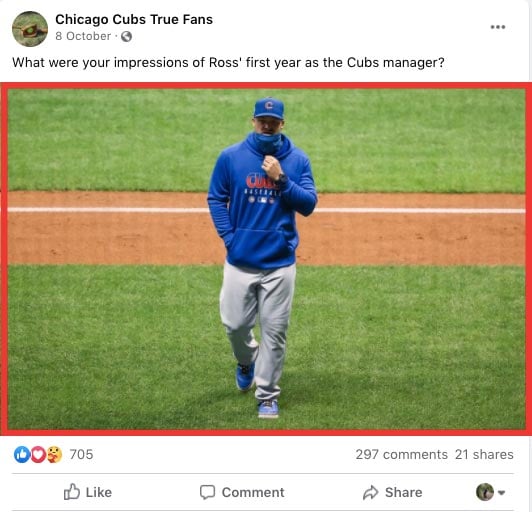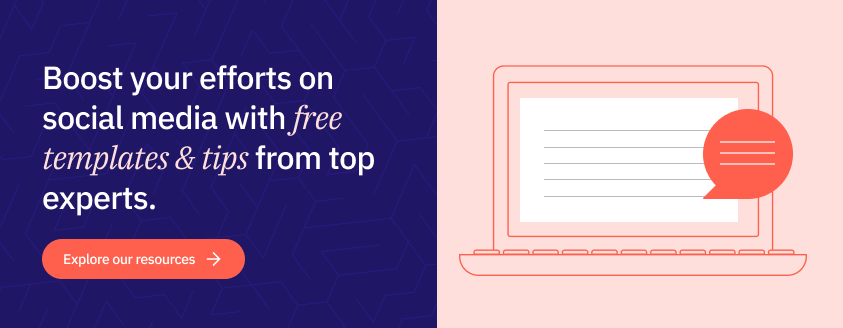‘Does using a 3rd-party posting tool like Sendible hurt my brand’s organic reach and engagement on Facebook?’
It’s the million-dollar question that every social media marketer wants the answer to.
Why? It’s simple. If you spend hours every day crafting social media posts, you want reassurance that they’ll have the best possible chance of being seen by your brand’s Facebook following.
...Because when your posts are seen by the right people, the likelihood of conversions and ultimately, sales, are increased.
With so much at stake, it’s unsurprising that so many theories exist to explain why posts might not perform as well as hoped.
For every marketer who blames third-party scheduling tools for their posts’ declining organic reach on Facebook, there’s another who will hold Facebook’s ever-changing algorithm responsible.
So, what is the role of third-party tools in the success of your brand’s Facebook posts?
In this guide, we set out to decipher exactly that. How? By carrying out our own research into the engagement and reach of Sendible users’ Facebook posts.
We’re excited to show you the insights we’ve gained from our research. So, if you’d like to learn more on this hot button topic, as well as garner advice on how to boost the organic reach of your Facebook posts, then keep reading.
How we set up our research
This section covers how we organised our research, as well as how we arrived at our results.
Although a few other social media management platforms including Buffer and Agorapulse have carried out similar research into the effect of third-party scheduling tools on social media post reach and engagement, ours differs.
This is because, rather than setting up a live experiment, which is very time-intensive, we chose to analyse data that was readily available to us.
Here’s how we did it:
Where did we gather our data from?
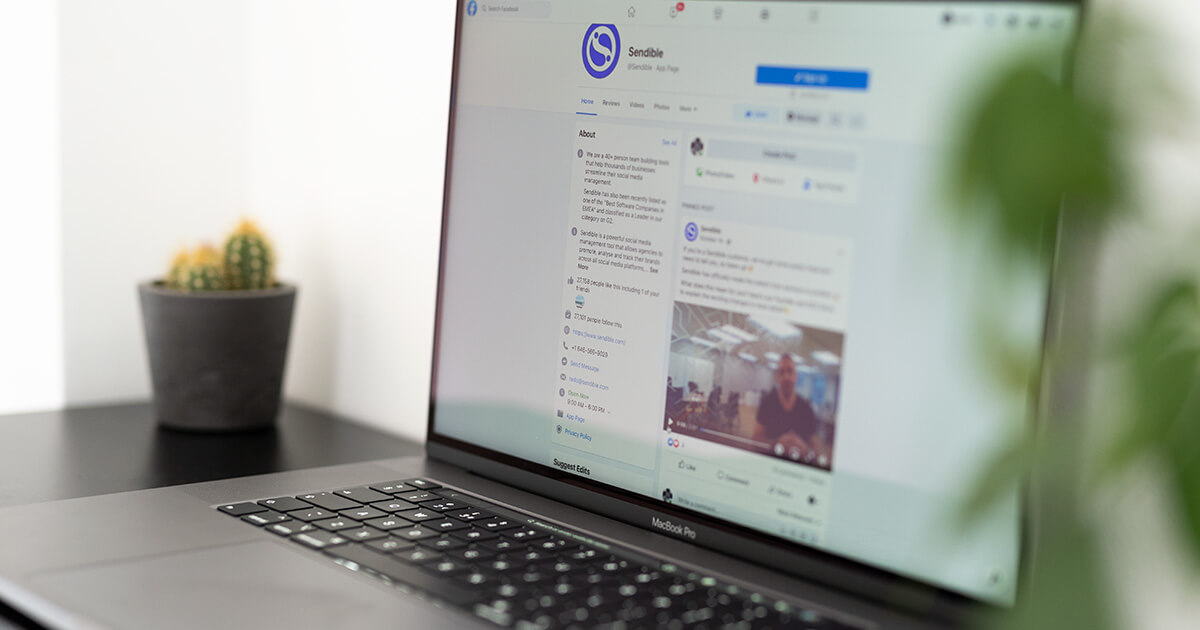
In order to understand the levels of reach and engagement that Sendible users were achieving on their Facebook posts, we turned to Facebook’s Open Graph API.
For anyone who's wondering, API stands for application programming interface and is the gateway that allows two applications - in this case, Sendible and Facebook - to communicate with each other and access reporting data. This is the same interface that's used when you create and schedule posts to Facebook.
API restrictions are the reason why no third-party tool can offer the same functionality as the native platforms. It’s why you can’t schedule carousel posts to Instagram via Sendible, just yet.
Facebook’s Open Graph API allows you to access key information about Facebook users posts. This could be page information, such as how many fans a Facebook page has, as well as specific post information, such as the number of likes or impressions that a particular post has gotten.
By accessing this API, we were able to view detailed information about the posts that our users had scheduled via Sendible, including their engagement rates.
How many posts did we analyse?
In total, we analysed over five thousand posts from 58 different Facebook pages, all of differing sizes and from varying industries.
The smallest page we looked at had a following of 196 page fans and the largest page had a following of 6,624,360 page fans.
For variety, we also looked at posts from a broad range of industries.
These spanned from non-profits to e-commerce brands, news sites, sports clubs and restaurants. There were also posts from businesses with backgrounds in automotive sales, politics and art.
What time frame did we use?
We looked at roughly 100 of the latest posts from all 58 pages, spanning the last few months, with most of them being published in September and October 2020.
How did we arrive at our results?
We began by narrowing down the criteria for what we wanted to measure.
Firstly, we knew that we wanted to understand more about the engagement rates of each of the posts that we’d selected to analyse, so that was our starting point for deciding which data to pull.
The data points that we considered most important for understanding overall reach and post engagement rates were:
- Application - where the post was posted from (third-party tool or natively from Facebook)
- Post engaged user rate - the total number of engagements that the post received on Facebook
- Post impressions - the total number of Facebook users who saw the post on their newsfeed
- Post type - link, photo or video
Once we’d pulled this data for all 58 pages, we then calculated the average engagement rate for posts that were scheduled or published via different applications - these applications included platforms such as Instagram or other third-party tools including Buffer and Hootsuite.
Next, we drilled down further into the data and aimed to find out whether there was any difference in average engagement rate for posts that were scheduled or published via different applications per different post type - this included links, photos or videos on Facebook.
Finally, we calculated the native vs third-party engagement rates for posts and compiled the data into tables for visibility.
5 learnings from our research into Facebook's reach & engagement rates when posting natively vs from a 3rd-party tool
Here are the key findings from our research:
- Overall, posts that were scheduled to Facebook via third-party tools achieved 10.3% more engagement than those posted natively. (Increase of 0.6 percentage points)
- Posting links to Facebook via third-party posting tools like Sendible actually achieved 52.9% more engagement when compared to those that were posted natively. (Increase of 2.7 percentage points)
- On average, photo posts achieve 32.2% less engagement when they’re published by third-party tools rather than from Facebook’s native platform. (Decrease of 1.9 percentage points)
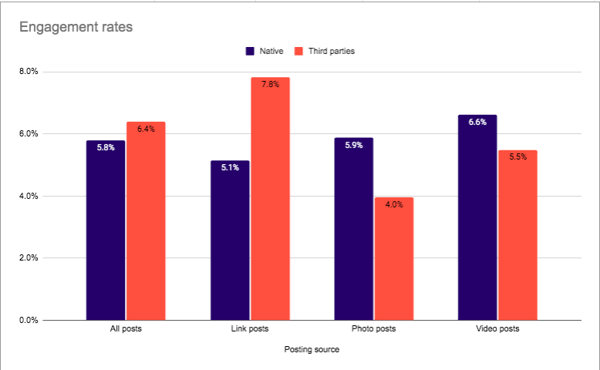
- By cross-posting to Facebook via Instagram, engagement takes a hit. For both photo and video posts, we saw a decrease of about 5-10% in engaged user rate. (Decrease of 0.3 percentage points)
- Posting videos via third-party tools like Sendible resulted in decreased engagement of about 20%. (Decrease of 1.1 percentage points)
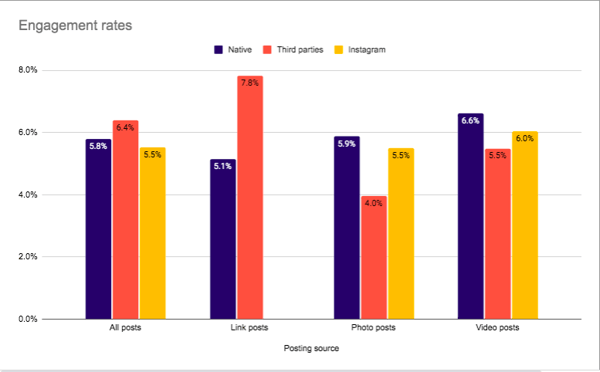
What realistic conclusions can we draw from this research?
The most surprising part of this research was seeing the huge difference in engaged user rates for link posts compared to photo and video posts.
We speculate that this might be connected to Facebook’s API restrictions when scheduling rich media posts on third-party tools. Whether that’s having to adjust your videos to match the length restrictions, or not being able to add a location tag on your photo. On the contrary, scheduling link posts is fraught with far fewer restrictions.
While there were also many other moving parts surrounding the research that we carried out - for example, the amount and varying quality of posts that were comparing - there are clear conclusions that we can draw from the data.
Firstly, and most importantly, posting via a third-party social media tool doesn’t decrease post engagement on Facebook overall.
In fact, the average engagement rate for a post on Facebook in 2020 is 3.6%, so an engagement rate of 6.4% is actually far above average and very impressive!
It’s also great news for social media marketers, who rely on tools like Sendible to do their jobs every day.
Another noteworthy finding from our data comes from looking at the engagement rate of content that is cross-posted to Facebook via Instagram.
We found that photo and video posts that are shared to Facebook via Instagram consistently achieve less engagement than posts published natively to Facebook.
While we already know that Facebook’s objective is to keep users on the platform for as long as possible, it’s interesting to see data supporting the idea that Facebook would cannibalise posts shared from their sister app in order to achieve this objective!
How does posting with 3rd-party tools affect Facebook reach?
We know that reach correlates with engagement, and we know that posting more engaging content results in better reach. Therefore, we can speculate that posts with higher engaged user rates would have a similarly high level of reach, on average.
In other words, if we know that a link post is more likely to achieve more engagement if posted through a third-party tool, then logically, the reach of the post shouldn’t be negatively impacted. However, we would need a much bigger data sample to confirm this finding in our own research.
Whatever your opinion on the relationship between third-party scheduling tools and Facebook reach, one thing’s for sure, the ability to schedule social media content in advance is a huge time saver for social media managers:
“Sendible has saved me a lot of time since I started using the service.”
Troy Roberson, Sendible customer
Not only can you ‘set and forget’ by bulk scheduling posts in advance, but being able to respond to comments from within one dashboard can also increase efficiency.
Additionally, smart features like Sendible’s optimal posting time help to optimise your posts by calculating the best times for you to post, based on your posting history over the previous 30 days.
So, by using a social media scheduling tool, social media managers are able to bring better posting consistency and quality to the content creation process:
“Love the Sendible app, been using it for years and it definitely assists with productivity and efficiency.”
Anicke Novi Steyn, Sendible customer
How to create Facebook posts that increase reach and engagement for your page
Here are some quick tips for creating Facebook posts that drive engagement. These best practices will help you to ensure that you get the best return on investment from your posts.
Post a variety of content
Although video is the best performing content type on Facebook, there’s always room for experimentation.
To ensure you’re hitting the mark with your content, mix it up and post a combination of videos and photos, as well as links to relevant and helpful resources.
Here are a couple of examples of content you could try experimenting with on Facebook:
- User-generated content posts
There’s nothing more authentic or powerful than social proof, so why not try enlisting the help of your customers to promote your offering on Facebook, just like Fitbit: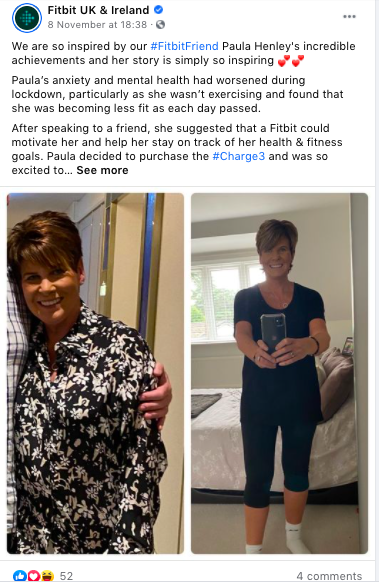
- Hashtag holiday themed posts
Celebrating popular holidays on Facebook can be a great way to get your followers to engage. They can also be fantastic for showing off your brand's offering, especially when it’s super relevant - just like #WorldVeganMonth is to plant-based food company Moving Mountains foods. Just make sure you’ve got a social media holidays calendar at the ready!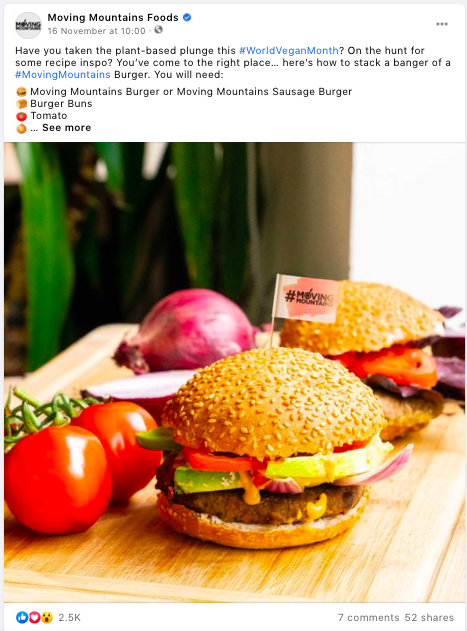
- Question posts
Social media isn’t about your brand, it’s about your audience! So, why not try asking them how they’re doing once in a while - their answers might surprise you and spark up a conversation.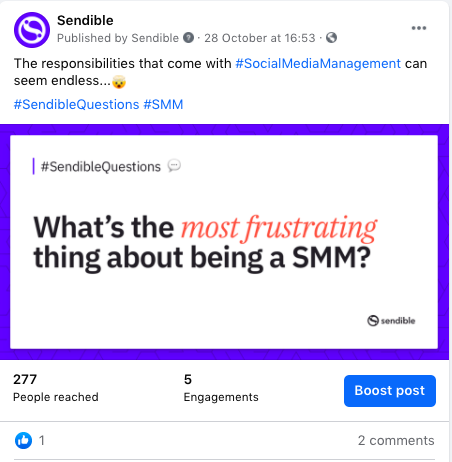
>>Pro tip>> Keep measuring and tracking the performance of your brand’s posts and report on your findings.
Use hashtags to increase reach
Although using hashtags might be a practice more commonly associated with Twitter, they’re also popular on Facebook and can increase the reach of your brand’s posts.
While hashtags can add value to your brand’s Facebook posts, use them sparingly, as posts with fewer hashtags tend to perform better.
Here’s an example of a Facebook post from Cafe piazza, which makes good use of hashtags. Notice how all of the hashtags used in the post are relevant to the business that’s being promoted:
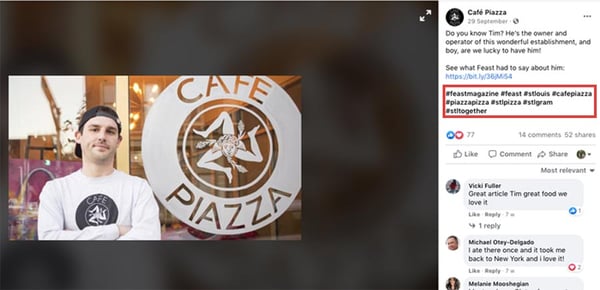
Make strong copy choices
We recently asked our followers what the hardest thing about being a social media manager was, and this was one of the responses we got:

What digital marketing agency Kowala Creative says is true - coming up with copy that converts is challenging.
Here are some tips to remember when creating copy for your brand’s Facebook posts:
- Cement your brand’s tone of voice with your copy
- Don’t overcomplicate your messages with jargon
- Use storytelling to frame your copy and illustrate your message
- Be direct and avoid using passive voice
Notice how the caption of this post from dance company L.A. Dance tells a story. It includes plenty of personal details, fits the accompanying photo perfectly and invites the reader to engage:
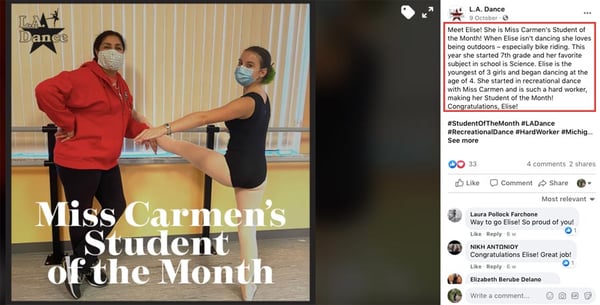
Use high-quality visuals
According to research, Facebook posts that contain images see 2.3 times more engagement than those without.
So, there’s clearly something to be said for using eye-catching visuals.
Whenever you add content to your brand’s Facebook posts, make sure that the image or video is optimised for the platform and that the image size is correct.
Take this photo post from the Chicago Cubs True Fans Facebook page, which has a really high engagement rate. Notice how striking and bold the image is. It’s also optimised for Facebook and stands out on the newsfeed too:
Wrapping up
Social media management is a juggling act.
The reality is, there are so many elements that contribute to the overall post reach and engagement of a Facebook business page, including factors like page size and how active and engaged your audience are.
However, if there’s one thing that’s worth taking away from this article, it’s that making the decision to use a social media publishing tool like Sendible to increase productivity and save time, won’t harm the engagement of your Facebook posts.
Now that we know this for sure, it’s time to apply that knowledge and create some winning Facebook posts.
Don’t be afraid to embrace a trial and error approach and let us know how you get on!

